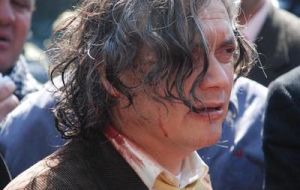MercoPress. South Atlantic News Agency
Hundreds arrested in Santiago de Chile labor protest
 Senator A. Navarro bleeds after a police hit him at the march
Senator A. Navarro bleeds after a police hit him at the march Police prevented members and supporters of Chile's largest labor union – the United Workers Central (CUT) – from marching through the streets of the capital Santiago on Wednesday, after union leaders deliberately failed to seek authorization for their protest.
But demonstrations in most other parts of Chile went unhindered by police and drew significant support. The demonstrations, which also occurred concurrently in regional cities, were called by the CUT in order to protest endemic inequality in Chile, where the wage disparity between floor workers and management is 200 to one. Salary differences in most developed countries are on the order of eight to one. CUT leaders initially characterized the demonstrations as part of a "day of action" meant to demand greater economic equality and to end "neo-liberal" economic practices. Permits were not requested by organizers because the protests were predicted to be numerous, occurring in various locations throughout Santiago. CUT officials also requested members and supporters to protest in as many creative ways as possible and not rely solely on the street protests. Actions recommended included arriving late for work, distributing union flyers at work, or displaying banners supportive of labor union activity. Clad in head-to-toe riot gear, Santiago's police positioned themselves strategically throughout the city in the early morning hours, preparing for a protest that was predicted to be the nation's largest since the fall of the Pinochet regime. Initial plans by CUT organizers called for 10:00am rallies at four central Santiago locations, followed by marches to a central meeting point. Still, clashes between police and protesters began almost as soon as the city awoke, with 19 arrests reported by 9:30 am. An estimated 3,000 protesters met at Plaza Italia early Wednesday morning, where CUT Secretary-General Jaime Gajardo attempted to address the sprawling crowd about the union's goals for the demonstration. "We are here today to ask for a real change. [We ask for] a reform of the labor system, and not just a superficial reform, but true reform," said Gajardo. "The objective of today, and the labor union's demands, are that we want labor reform, better wages, and education reform...We want true representation, electoral reform, and no more exclusion." From Plaza Italia, demonstrators attempted to march down the Alameda, central Santiago's primary artery. A legion of mounted police immediately blocked their progress, but protesters soon began to block traffic at nearby intersections. In a show of force, police dispersed much of the crowd with tear gas and water cannons, while some protesters retaliated by hurling stones at well-protected police vehicles. The marchers that remained eventually proceeded down the Alameda. At each intersection they were confronted by more tear gas, with police intermittently making arrests. Among those who continued the march were Socialist Party (PS) Senator Alejandro Navarro and Gajardo. In a widely reported incident, Navarro was struck on the head with a blunt instrument by a policeman near Plaza Italia. As he continued the march afterwards, Navarro denounced the police response. "The government should understand that the people have the right to demonstrate. And most of the protesters were peaceful, so the police do not have to use violence" Navarro told The Santiago Times. "We said that after the first signs of violence, we would not retreat. A hit from behind? That can't be justified. An official hit me on the head. Unfortunately, it was a police officer". Santiago Police Chief Patricio Reyes later apologized to Sen. Navarro for the incident, but the Senator said he planned to sue the Carabineros police for his injury. The Alameda remained contested territory throughout the day, as police utilized similar tactics against groups of protesters near La Moneda presidential palace, Universidad de Chile, and Estacion Central. By late afternoon, most protest activity had ended. At press time, Santiago police reported that nearly 400 protestors had been detained. Meanwhile, the day's incidents have left 11 police officers injured. Both statistics are expected to rise after evening falls. Similar demonstrations took place in many of Chile's regional cities. Initial reports indicate that these events were successful and were not marred by violence. "We are extremely satisfied with how things went. I think that our biggest success was the ample participation which we were able to obtain," Robert Aravena Sepulveda, President of the CUT branch in Valparaiso, told The Santiago Timeslate Wednesday. "Almost all of Valparaiso's unions were involved, from both the public and private sector. It was a great success." Demonstrations in Temuco were also termed successful by CUT officials, with attendance figures surpassing their expectations. "We managed to occupy 10 blocks in the center of Temuco. We brought together between 5,000 and 6,000 people. Fishers, farmers, and people from all social classes participated," Julio Palmer, Vice-President of CUT Temuco told The Santiago Times. "This march was an absolute success. In the past, we had tried to organize marches, but only a few hundred people came out. But now, this has changed. We have gotten many more people involved, including people from different political parties." By T. Pollard, K. De Leeuw, and M. Malinowski The Santiago Times




Top Comments
Disclaimer & comment rulesCommenting for this story is now closed.
If you have a Facebook account, become a fan and comment on our Facebook Page!